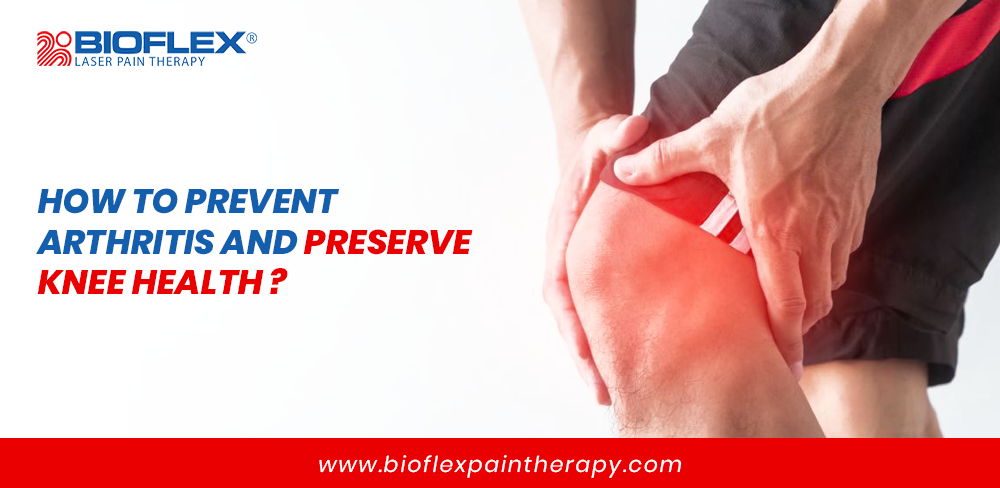Conquering Arthritis: Your Roadmap to Preserve Knee Health
Our knees are the workhorses of our bodies, carrying us through life’s adventures. But when knee pain strikes, it can slow us down and leave us frustrated. However, by understanding causes, diagnosis, and treatment options empowers individuals to manage it effectively. Whether through conservative measures, medical interventions, or lifestyle modifications, there are numerous strategies to reduce pain, enhance function, and preserve knee health.
As we age, the risk of developing knee problems, including arthritis, increases. Arthritis, marked by inflammation and stiffness in the joints, can significantly impact mobility and lifestyle. However, proactive measures can help prevent arthritis and preserve knee health. It’s essential to prioritize preventive care and listen to your body, seeking medical attention if you experience persistent arthritis pain or discomfort. With proper attention and care, you can keep your knees strong, flexible, and pain-free.
This article delves into practical strategies to preserve knee health and prevent the onset of arthritis. Thus it emphasizes proactive steps for long-term well-being.
Arthritis: The Mystery of Stiff Joints
Arthritis, a term encompassing over 100 different types of joint diseases, affects millions of people worldwide. It’s a leading cause of disability, impacting individuals of all ages, genders, and ethnicities. While commonly associated with aging, arthritis can affect anyone, including children and young adults.
Arthritis refers to inflammation of the joints, thus resulting in pain, stiffness, swelling, and reduced range of motion. This condition can develop gradually or suddenly, and its severity can vary from mild discomfort to severe debilitation. With time, arthritis can cause joint damage and deformity, significantly impacting an individual’s quality of life.
Beyond the Aches: Unveiling Types of Arthritis
Osteoarthritis (OA)
The most common type, often referred to as “wear and tear” arthritis, develops when the protective cartilage cushioning the ends of bones deteriorates over time. This results in bones rubbing against each other, thus causing pain and stiffness. OA commonly affects joints in the hands, knees, hips, and spine.
Rheumatoid Arthritis (RA)
It is an autoimmune disorder where the body’s defence system mistakenly attacks the synovium, the lining of the membranes that surround the joints. This leads to inflammation, pain, and eventual joint damage. RA commonly affects the hands, wrists, and knees and can also involve other organs, such as the heart and lungs.
Juvenile Arthritis
Any form of arthritis or arthritis-related conditions that develop in children and teenagers. Juvenile arthritis can be similar to adult forms of arthritis, such as RA or OA. Furthermore, it can also include other conditions unique to children, such as juvenile idiopathic arthritis (JIA).
Ankylosing Spondylitis
A type of inflammatory arthritis that mainly targets the spine, thus causing stiffness, pain, and eventually fusion of the vertebrae. Moreover, it can also affect other joints and organs, such as the eyes.
Psoriatic Arthritis
It is a type of arthritis that develops in individuals with the skin condition psoriasis. It can impact any joint in the body and may result in swelling of the fingers and toes, a condition referred to as dactylitis.
These are just a few examples of the many types of arthritis, each with its own unique characteristics and treatment approaches.
Arthritis Impact on Knee Health
The knees are particularly susceptible to arthritis due to their weight-bearing nature and the significant stresses they endure during everyday activities. As arthritis progresses, individuals may experience difficulty walking, climbing stairs, and performing routine tasks, ultimately impacting their independence and overall well-being.
Uncovering the Culprits: Common Causes
The common causes of arthritis and knee pain can change based on the type of arthritis or underlying condition. Here are some common culprits:
Age Factor
As individuals age, the risk of arthritis, including knee pain from conditions like osteoarthritis, rises over time because of the natural wear and tear experienced by the joints.
Autoimmune Factors
Autoimmune forms of arthritis, such as RA, can lead to knee pain as the body’s immune system mistakenly attacks healthy joint tissue.
Joint Injuries
Trauma or injuries to the knee joint, such as ligament tears or fractures, can contribute to the development of arthritis and subsequent knee pain later in life.
Joint Overuse
Excessive use or repetitive strain on the knee joints, common in certain occupations or sports, can lead to knee pain and increase the likelihood of developing arthritis.
Infections
Infections caused by bacteria or viruses can sometimes trigger reactive arthritis, resulting in knee pain as the immune system reacts to the infection.
Obesity
Extra weight puts increased pressure on the knees, hips, and spine, raising the risk of knee pain associated with arthritis, especially osteoarthritis.
The Diagnosis Journey
Diagnosing arthritis and knee pain typically constitutes a combination of medical history, physical examination, imaging tests, and sometimes laboratory tests. Hence, healthcare providers usually follow a series of steps for diagnosis, which may include:
Medical History
The healthcare provider will begin by discussing the individual’s symptoms, including the location, duration, and severity of knee pain, as well as any factors that worsen or alleviate the pain. They may inquire about previous injuries, medical conditions, and family history of arthritis, and lifestyle factors that could contribute to knee problems.
Physical Examination
A comprehensive physical examination of the knee joint is conducted to assess for signs of inflammation, swelling, tenderness, and range of motion. Healthcare providers may also perform specific movements to evaluate ligament stability and joint integrity.
Imaging Studies
Imaging tests such as X-rays, MRI, or computed tomography (CT) scans may be ordered. These can be utilised to visualize the internal structures of the knee joint and identify any abnormalities, such as cartilage damage, bone spurs, or signs of arthritis. Additionally, X-rays are commonly used to detect osteoarthritis, while CT scans and MRIs provide detailed images of soft tissues and can help diagnose rheumatoid arthritis or other inflammatory conditions.
Laboratory Tests
Sometimes, blood tests may be recommended to rule out underlying problems such as rheumatoid arthritis, gout, or infections that could be contributing to knee pain.
Specialized Test
Depending on the specific symptoms and suspected diagnosis, healthcare providers may perform additional specialized tests, such as arthroscopy, joint aspiration, or ultrasound, to evaluate the knee joint and surrounding structures further.
Pain-Free Knees: Treatment Strategies for Arthritis
Effective treatment strategies play a crucial role in preserving knee health and reducing pain, enabling individuals to maintain an active lifestyle and overall well-being.
Medication Management
Medications are often utilized to manage knee pain, particularly in cases of inflammation or discomfort. Nonsteroidal anti-inflammatory drugs (NSAIDs) like ibuprofen or naproxen can reduce pain and swelling from conditions like Osteoarthritis or tendonitis. It’s crucial to use these under healthcare guidance due to potential long-term risks. Corticosteroid injections offer temporary relief, aiding in physical therapy, but overuse may harm joint health.
Invasive Interventions
In some cases where conservative treatments are ineffective, surgical interventions can be utilized. These include arthroscopy, osteotomy, or joint replacement surgery. These procedures may be recommended to repair damaged tissue, realign the joint, or replace severely damaged or degenerated joints. These procedures can significantly improve mobility and quality of life for individuals with advanced arthritis.
Proactive Steps: Preserving knee health and Staying Active
Preventing knee pain involves adopting healthy lifestyle habits and minimising risk factors. Here are some preventive measures to consider:
Maintain a Healthy Weight
Excess weight places added strain on the knees. Thus increasing the risk of osteoarthritis and exacerbating existing joint pain. Additionally, maintaining a healthy lifestyle based on regular exercise and balanced nutrition can help manage weight. Moreover, it can reduce strain on the knees.
Incorporate Strength Training
Strengthening the muscles that support the knees, including the calf muscles, quadriceps, and hamstrings, can help reduce the risk of injury and stabilize the joints. Incorporate exercises such as leg presses, squats, lunges, and calf raises into your fitness routine to build strength and endurance.
Practice Proper Body Mechanics
Pay attention to your posture and body response during daily activities in order to minimize strain on the knees. Use proper lifting techniques, avoid excessive bending or twisting motions, and use supportive footwear with adequate arch support and cushioning for maintaining proper alignment and reducing stress on the joints.
Warm Up and Cool Down
Before working out, warm up with stretching exercises to increase blood flow towards the muscles and prepare the joints for exercise. Afterwards, cool down with static stretches to improve flexibility and prevent stiffness. Incorporating these routines into your workout regimen can help patients recover and reduce injury risks.
Use Proper Protective Gear
If you participate in sports or activities that pose a risk of a knee injury, such as skiing, skateboarding, or basketball, wear appropriate protective gear, such as knee braces or pads, to reduce the likelihood of trauma and protect the joint from impact.
Conclusion
In conclusion, effective arthritis treatment strategies are vital to preserve knee health and pain reduction, enabling individuals to lead active and fulfilling lives. By combining medication management, physical therapy, invasive interventions, and complementary therapies, healthcare providers can address a wide range of knee conditions and facilitate optimal outcomes for patients.
It’s essential for individuals experiencing knee pain to seek prompt evaluation and treatment from a qualified doctor to determine the appropriate course of action. With comprehensive treatment approaches and a commitment to self-care, individuals can experience significant improvements in knee function, mobility, and overall quality of life.


